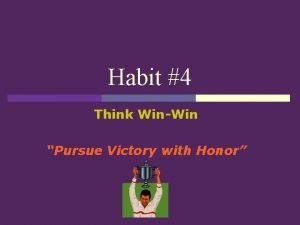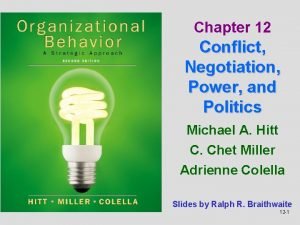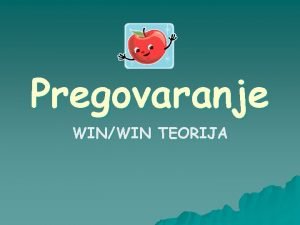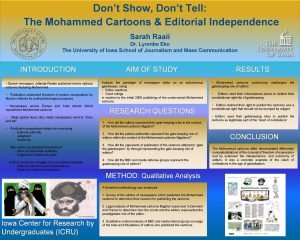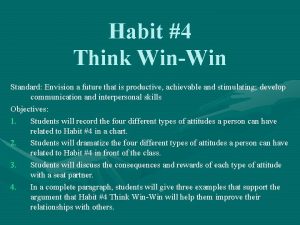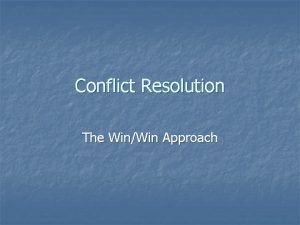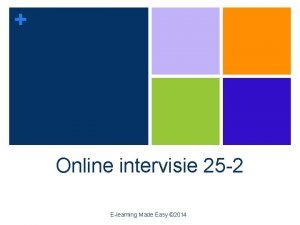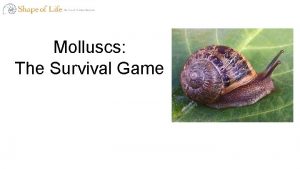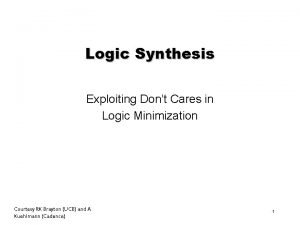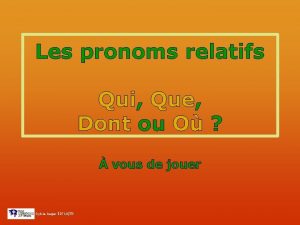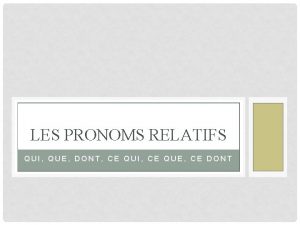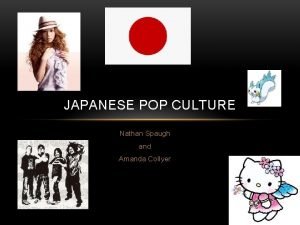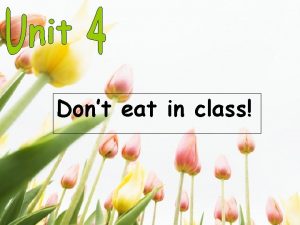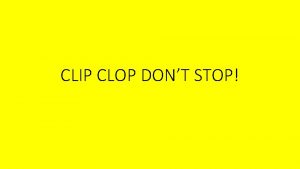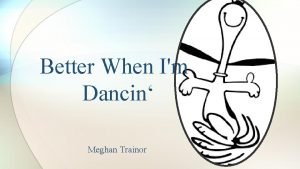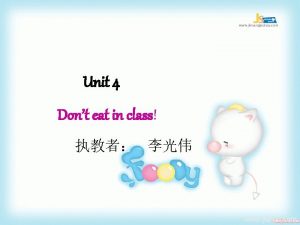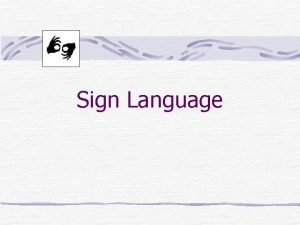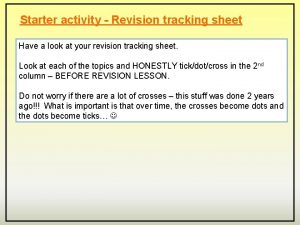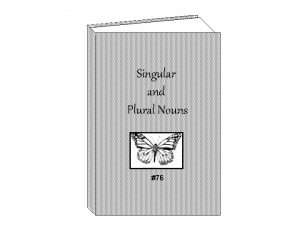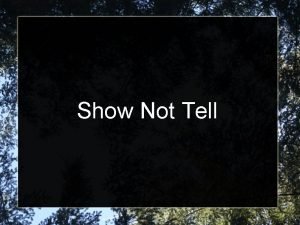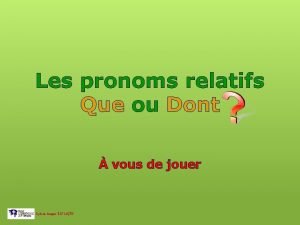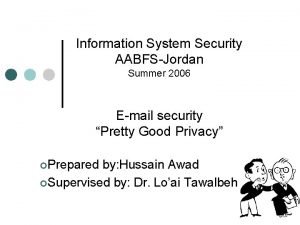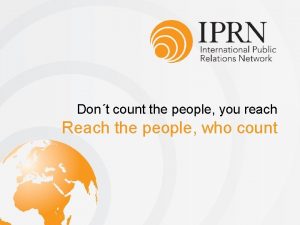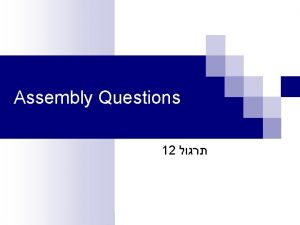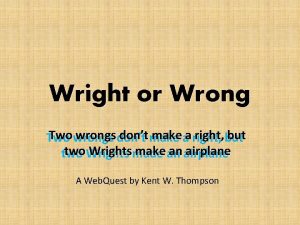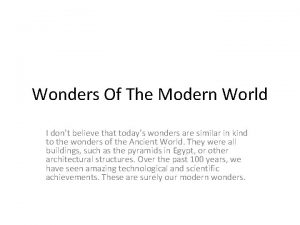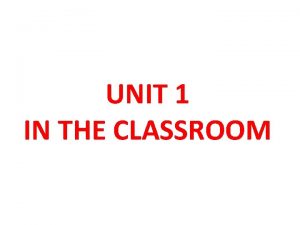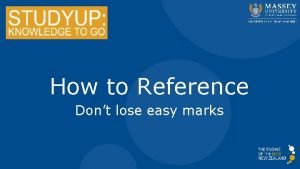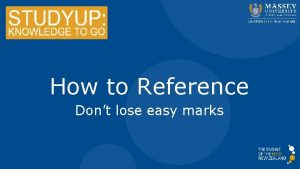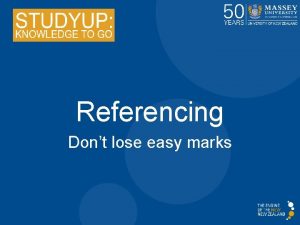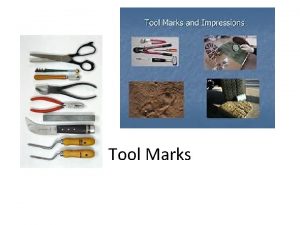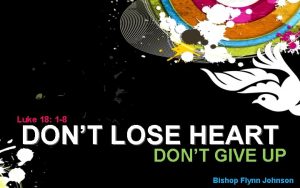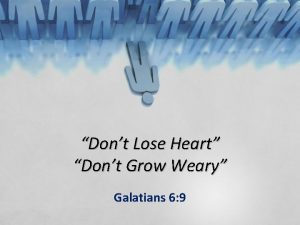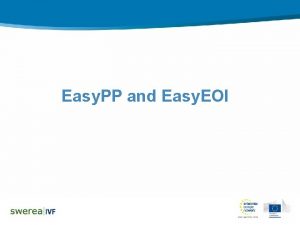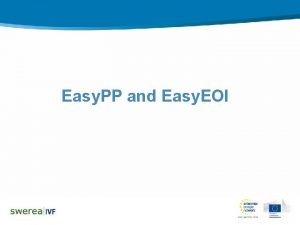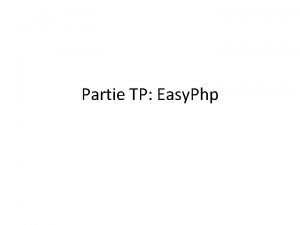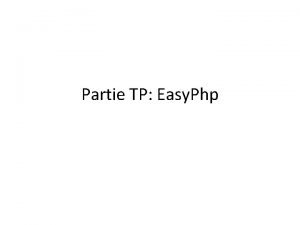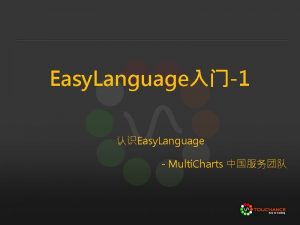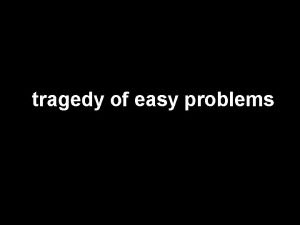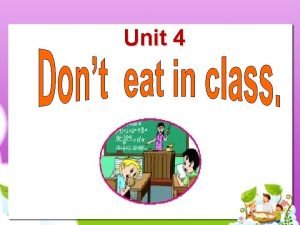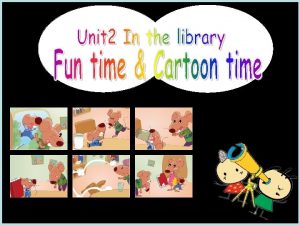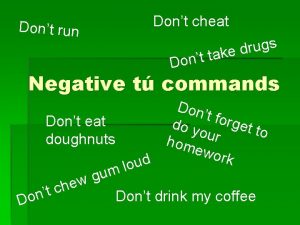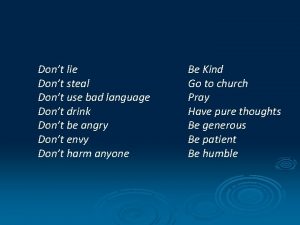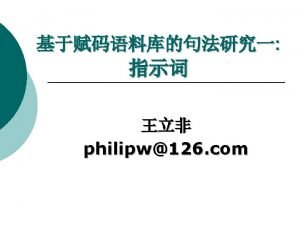How to Reference Dont lose easy marks Learning













































- Slides: 45

How to Reference Don’t lose easy marks

Learning outcomes At the end of this session, you will be able to: • include citations when required • write in-text citations in APA style (7 th edition) • format an APA reference list including books, book chapters, articles and web pages

PART 1 When do you need to include citations?

Referencing is used to tell the reader the source of any information which you’ve found in a book, article, website etc and have included in your text When you refer to other work you need to have: • in-text citations (each time you include information or quotations from your research) • a reference list (with complete details of all the sources you’ve referred to on a separate page at the end of your text)

INTERACTIVE TASK 1 You’re going to read a paragraph a student has written about an ethical theory called Utilitarianism. There are no citations. Write: • How many citations you think the writer should have included. Think about: • The lecturer’s reaction to this paragraph. • What if the student wrote the whole thing from memory, without referring to any books?

Utilitarianism is a consequentialist theory of ethics. This means that it focuses on the consequences of an action and not the action itself. In the words of one of the most influential Utilitarians, John Stuart Mill, an action is moral if it brings the greatest happiness to the greatest number. One strength of this approach is that it focuses on observable human behaviour, instead of discussing the rights or wrongs of actions in relation to abstract concepts of justice. However, critics have pointed out that Utilitarianism implies that happiness can be objectively measured, in the same way as, for example, health or economic outcomes. It has also been criticised for offering a justification for actions such as murder, which are generally regarded as inherently wrong, regardless of any positive outcomes which might occur. • How many citations do you think the writer should have included?

The same paragraph with citations Utilitarianism is a consequentialist theory of ethics. This means that it focuses on the consequences of an action and not the action itself (Brown, 2013). In the words of one of the most influential Utilitarians, John Stuart Mill, an action is moral if it brings “the greatest happiness to the greatest number” (Smith & Jones, 2008, p. 23). One strength of this approach is that it focuses on observable human behaviour, instead of discussing the rights or wrongs of actions in relation to abstract concepts of justice. However, critics have pointed out that Utilitarianism implies that happiness can be objectively measured, in the same way as, for example, health or economic outcomes. It has also been criticised for offering a justification for actions such as murder, which are generally regarded as inherently wrong, regardless of any positive outcomes which might occur (Patel, 2003).

Number of citations • The student has used one book for the basic information; another book for the quotation from Mill; and a third book for the pros and cons of Utilitarianism. • If the student had used the same book for all of these things, it would look like the paragraph on the next slide…

The same paragraph with citations Utilitarianism is a consequentialist theory of ethics. This means that it focuses on the consequences of an action and not the action itself (Brown, 2013). In the words of one of the most influential Utilitarians, John Stuart Mill, an action is moral if it brings “the greatest happiness to the greatest number” (Brown, 2013, p. 23). One strength of this approach is that it focuses on observable human behaviour, instead of discussing the rights or wrongs of actions in relation to abstract concepts of justice. However, critics have pointed out that Utilitarianism implies that happiness can be objectively measured, in the same way as, for example, health or economic outcomes. It has also been criticised for offering a justification for actions such as murder, which are generally regarded as inherently wrong, regardless of any positive outcomes which might occur (Brown, 2013).

Number of citations • It still has three citations, because the student needed to give a page number for the quotation. This means they still need the other two – to show the reader where that information has come from. • Which version do you think looks more credible? The one based on a single book, or the one based on three different books? • See more examples of well-researched and cited paragraphs in the Study Up ‘Constructing a paragraph’ handout.

How might the lecturer react to the paragraph without citations? • LOW or FAIL grade: This is regardless of how ‘true’ the ideas are, or how well it was written. • Possible academic PENALTY (see the Study Up recording session on ‘How to avoid plagiarism’, and also check out the weblinks below on Plagiarism and Massey Academic Integrity policy).

What impression does it make if students claim they didn’t use any books etc? … maybe just heard the info ‘somewhere’. • LAZY! The whole point of uni assignments is for students to demonstrate that they can write research-based texts. • CARELESS! How can the student be sure that information was accurate and that they’ve remembered it and how can the lecturer check it?

So, when can you write something without a citation? • YOUR OWN IDEA. For instance, something that happened to you (in a reflective essay) or an original argument, not based on anything you’ve read (always worth checking if anyone else has come up with it before). • COMMON KNOWLEDGE. Something everyone knows – e. g. all your family and friends. Rarely worth including this in a university assignment though.

PART 2 How to write in-text citations in APA style (7 th edition)

• The examples of citations you’ve seen in this session (and previous Study Up sessions) use APA style (7 th edition). The rest of this session will focus on how to do APA citations and references according the 7 th edition of the APA publication manual. APA style (7 th edition) is used in many courses, such as Psychology, Education, Social Work, Management, Marketing etc.

• But a number of subjects use different styles. For example, in History, it’s more common to cite in-text with numbers, with the details of the source in a footnote at the bottom of the page (as well as in the reference list). • OWLL has information on some of the more common styles, such as APA, MLA and Chicago. Make sure you know which style you need to use (and ask your lecturer if you’d prefer to use a style you’re familiar with).

Without looking at your notes, can you write the first citation from the paragraph about Utilitarianism? Utilitarianism is a consequentialist theory of ethics. This means that it focuses on the consequences of an action and not the action itself (Brown, 2013). This is the most common way to write citations. First, you summarise the ideas in your own words. When you are finished, you put the surname of the author of the book or article you used and the year of publication inside brackets. The full stop goes after the closing bracket.

Again, without looking at your notes, can you write the second citation from the paragraph about Utilitarianism? HINT: It followed this phrase which was copied from page 23 of a 2008 book by George Smith and Phil Jones: In the words of one of the most influential Utilitarians, John Stuart Mill, an action is moral if it brings “the greatest happiness to the greatest number” (Smith & Jones, 2008, p. 23). Quotations are usually short (i. e. phrases which you drop into your own sentence) and need to be in double quotation marks. Quotations are also usually rare (i. e. just a few times in an essay, generally for definitions or especially striking phrases)

How would you write the citation for information from the Statistics New Zealand website? You can’t see any author’s name on the page, but it has 2015 at the bottom. Write down your suggestion. Only one in a hundred New Zealand women has an annual income over $100, 000 (Statistics New Zealand, 2015).

How would you write the citation for information from a chapter by Paul Cooper and Roger Mee in a 2016 book edited by Romula Jennings and Harriet Cooper? Write your suggestion down. Scientific Management continues to be influential in organisations such as call centres, in which tasks can be standardised (Cooper & Mee, 2016).

When you want to focus especially on the authors (for instance, if the 2016 claim by Paul Cooper and Roger Mee is controversial), you could use ‘According to’ or put the authors at the beginning of the sentence. Write your suggestion for what you would write in the gaps below (it’s the same for both gaps). According to _________, Scientific Management continues to be influential in organisations such as call centres, in which tasks can be standardised. _________ argue that Scientific Management continues to be influential in organisations such as call centres, in which tasks can be standardised.

According to Cooper and Mee (2016), Scientific Management continues to be influential in organisations such as call centres, in which tasks can be standardised. Cooper and Mee (2016) argue that Scientific Management continues to be influential in organisations such as call centres, in which tasks can be standardised. For more about citations, download ‘A Handy Guide to APA Referencing’ from the File Box and use APA Interactive (see the web link below).

INTERACTIVE TASK 2 You’re going to read a paragraph a student has written about humanistic management theories. There are four citations. Write: • Which ones you think have been written incorrectly. Think about: • Whether or not the quotations were worth including, or if the student should have summarised those ideas in his / her own words.

Humanistic alternatives to classical organisational theory emerged in the 1930 s. Barnard, for instance, saw informal networks as the lifeblood of organisations, enabling effective communication while allowing individuals to flourish (Gabor and Mahoney, 2013). Parker Follett argued that leadership is based on a thorough understanding of the contexts, practices and relationships that allows one to “grasp a total situation” (1987, p. 51) and then to ensure that the whole team (including oneself) is following “the invisible leader – the common purpose” (57). It has been argued that this understated form of leadership has become increasingly relevant in modern, teambased organisations (Chrislip, 2002).

Corrected version Humanistic alternatives to classical organisational theory emerged in the 1930 s. Barnard, for instance, saw informal networks as the lifeblood of organisations, enabling effective communication while allowing individuals to flourish (Gabor & Mahoney, 2013). Parker Follett (1987) argued that leadership is based on a thorough understanding of the contexts, practices and relationships that allows one to “grasp a total situation” (p. 51) and then to ensure that the whole team (including oneself) is following “the invisible leader – the common purpose” (p. 57). It has been argued that this understated form of leadership has become increasingly relevant in modern, team -based organisations (Chrislip, 2002). These three were incorrect first time! This is how they should have looked

Many authors: In-text citations for works with three or more authors include only the first author name and “et al. ” (which means “and others” in Latin) is used in all citations, including the first in-text citation. For example: (Smith et al. , 2019). Smith et al. (2019).

PART 3 How to write end-of-text references in APA style

The most common references are to these four types of expert source: BOOKS ARTICLES IN SCHOLARLY, PEER-REVIEWED JOURNALS CHAPTERS IN EDITED BOOKS CREDIBLE WEBSITES

INTERACTIVE TASK 3 You’re going to see an APA reference list which includes all of these types of sources. Write: • Which of the four types of source appears more than once. Think about: • The order of the references. • Where the different lines start.

References Biggins, G. (2009). Why I became a social worker. In P. Te Ara & T. Rogers (Eds. ), Social work and social workers in New Zealand/Aotearoa (pp. 102 -120). Insight Press. Hamel, G. (2000). Leading the revolution. Harvard Business School Press. Hubbard, J. , Thomas, C. , & Varnham, S. (2001). Principles of law for New Zealand business students (2 nd ed. ). Pearson Education. Silverblatt, A. (2004). Media as a social institution. American Behavioral Scientist, 48(1), 35 -42. https: //doi: 10. 1080/09585190802707433 Statistics New Zealand. (2009). Mapping trends in the Auckland region. http: //www. stats. govt. nz/Publications/Population. Statistics/mappingtrends-in-the-auckland-region. aspx

An APA reference list: • should consist of expert sources • includes only the sources you have cited • is on a separate page at the end of your essay/report with the title ‘References’ • is ordered alphabetically by author • has a hanging indent (i. e. only the first line of each reference begins at the left margin (see the last slide in your handout for tips on how to do this) Look again at the example (on the next slide).

‘References’ top and centred References Alphabetical order Biggins, G. (2009). Why I became a social worker. In P. Te Ara & T. Rogers (Eds. ), Social work and social workers in New Zealand/Aotearoa (pp. 102120). Insight Press. Hamel, G. (2000). Leading the revolution. Harvard Business School Press. Hubbard, J. , Thomas, C. , & Varnham, S. (2001). Principles of law for New Zealand business students (2 nd ed. ). Pearson Education. Silverblatt, A. (2004). Media as a social institution. American Behavioral Scientist, 48(1), 35 -42. https: //doi: 10. 1080/09585190802707433 Statistics New Zealand. (2009). Mapping trends in the Auckland region. Hanging indent http: //www. stats. govt. nz/Publications/Population. Statistics/mappingtrends-in-the-auckland-region. aspx

BOOK Hamel, G. (2000). Leading the revolution. Harvard Business School Press. surname, (year) initial For more than one author, include all names with initials (followed by. and , ) title (edition) publisher This is how you indicate second, third … edition Hubbard, J. , Thomas, C. , & Varnham, S. (2001). Principles of law for New Zealand business students (2 nd ed. ). Pearson Education.

CITY OF PUBLICATION Non-US books: In late 2019, the 7 th edition of the APA Publication Manual was released. APA 6 th ed. : Harmondsworth, England: Penguin. Unlike the 6 th edition, the 7 th edition does not give place of publication. US books: APA 7 th ed. : Penguin. APA 6 th ed. : Upper Saddle River, NJ: Lawrence Erlbaum Associates. APA 7 th ed. : Lawrence Erlbaum Associates.

CHAPTER IN EDITED BOOK Author of chapter and year of publication Title of chapter – not in italics Editors’ names (initial before) and (Eds. ) Biggins, G. (2009). Why I became a social worker. In P. Te Ara & T. Rogers (Eds. ), Social work and social workers in New Zealand/Aotearoa (pp. 102 -120). Insight Press. Publisher Title of book – in italics Page numbers of chapter – in brackets with pp. before

ARTICLE IN A SCHOLARLY JOURNAL author’s name year Title (no italics; not in capitals) Silverblatt, A. (2004). Media as a social institution. American Behavioral journal name Scientist, 48(1), 35 -42. (italics; main words start https: //doi: 10. 1080/09585190802707433 volume number in italics; issue number in brackets with capitals) page numbers doi number (if the article has one or url if does not have a doi)

WEB PAGE REFERENCE Year author’s name (if it’s missing put (n. d. ) (or organisation that owns the web site) Title of page Statistics New Zealand. (2009). Mapping trends in the Auckland region. http: //www. stats. govt. nz/Publications/P opulation. Statistics/mapping-trends-inthe-auckland-region. aspx. Note: APA 7 th edition does not use “Retrieved from”

INTERACTIVE TASK 4 You’re going to see another APA reference list in which two of these elements are missing: A) publisher B) page numbers C) volume and issue number Write: • The two letters representing the missing elements.

References New Zealand Ministry of Education. (2015). What we get for what we spend. http: //www. educationcounts. govt. nz/data/assets/pdf_file/0011/163685/What-we-getfor-what-we-spend-Inputs-outputs-and-outcomes-of-Govts-tertiary-educationexpenditure-2004 -2013. pdf Nicol, D. J. , & Macfarlane-Dick, D. (2006). Formative assessment and self-regulated learning: A model and seven principles of good feedback practice. Studies in Higher Education, 31(2). North, S. M. (1995). The idea of a writing center. In C. Murphy & J. Law (Eds. ), Landmark essays on writing centers. Parker, M. (1992). Post-modern organizations or postmodern organization theory? Organization Studies, 13(1), 1. Pascarella, E. T. , & Terenzini, P. T. (2005). How college affects students: A third decade of research. Jossey-Bass. A) publisher B) page numbers C) volume & issue numbers

References A & B were missing New Zealand Ministry of Education. (2015). What we get for what we spend. http: //www. educationcounts. govt. nz/data/assets/pdf_file/0011/163685/Wh at-we-get-for-what-we-spend-Inputs-outputs-and-outcomes-of-Govtstertiary-education-expenditure-2004 -2013. pdf Nicol, D. J. , & Macfarlane-Dick, D. (2006). Formative assessment and selfregulated learning: A model and seven principles of good feedback practice. Studies in Higher Education, 31(2), 199 -218. North, S. M. (1995). The idea of a writing center. In C. Murphy & J. Law (Eds. ), Landmark essays on writing centers (pp. 71 -85). Hermagoras Press. Parker, M. (1992). Post-modern organizations or postmodern organization theory? Organization Studies, 13(1), 1. Pascarella, E. T. , & Terenzini, P. T. (2005). How college affects students: A third decade of research. Jossey-Bass.

SUMMARY In this session you have learnt how to: • include citations when required • write an in-text citation in APA style • write end-of-text references for books, articles and web pages in APA style

Additional information A checklist for online sources Check the date: Is there a publication date? / When was content last updated? / Is the topic one that rarely changes or gets edited? Accuracy: Are sources used as evidence of facts? / Can information provided be verified through another source? / Does the site have grammar, spelling mistakes etc. ? Authority: Is the publisher known or reputable? / Is the sponsorship evident and is there a link to the sponsoring organization? / Are contact details (phone number or postal address) made available? / Is the author a known writer in this field/topic? Check the URL: What type of website is it …. com, . co. nz (commercial), . org. nz (organization), edu, or ac. nz (academic). Objectivity: Does it look professional? / Can you tell if the sponsor has any commercial interests? / Is there advertising on the page? / Are there any obvious biases present? Coverage: Are topics discussed in an in-depth manner? / Is the content full and complete? (OWLL, 2017; Tech-ease, 2017)

Referencing software • For a free download and more information about End. Note see tinyurl. com/masseyendnote • For help with End. Note, contact the library at Library@massey. ac. nz or go to tinyurl. com/masseylibraryquestions • For upcoming library sessions on End. Note see tinyurl. com/masseylibraryworkshops • You can find other free referencing applications at onenote. com, zotero. com and mendeley. com

How to indent a reference list (MS Word doc) Ø Write the list normally – with each reference ‘left-aligned’ like this: Silverblatt, A. (2004). Media as a social institution. American Behavioral Scientist, 48(1), 35 -42. Ø Then select the whole list. Ø Click on the ‘paragraph’ tab and on ‘special’. Ø Select ‘hanging’. Ø Click on ‘OK’. And the references will change to this: Silverblatt, A. (2004). Media as a social institution. American Behavioral Scientist, 48(1), 35 -42. Smile – it’s over!

Need help? We have a range of free services to help you with your assignment writing and study skills • • Individual Support: Want to discuss your assignment before you hand it in? Want to discuss study skills (e. g. how to manage time)? Book an appointment at massey. ac. nz/ctlcontacts or drop in. Pre-Reading Service: Submit a draft assignment and receive individual written feedback on your assignment’s structure, focus, referencing, and use of sources. This service is available to first year internal and all distance students. You can access the forum through the Academic Writing and Learning Support site on your Stream homepage. Workshops: Seminars and workshops are run on campus and online, which can help you with writing and study skills, such as essay writing, referencing, and writing research proposals. See here for programmes and registration details. See http: //owll. massey. ac. nz/about. OWLL/workshops. php Academic Q+A forum: Ask our consultants a question about academic writing and/or study skills. The Q & A forum is a place for students to receive help with quick, study-related questions. You can access the forum through the Academic Writing and Learning Support site on your Stream homepage. OWLL: Information about academic writing and study skills, including assignment planning, essays, reports, and referencing. Go to http: //owll. massey. ac. nz/index. php Disability Services: A range of services and support for students who have health and disability issues that are impacting their study. Pasifika@Massey: Whether studying as an internal or distance student, you can also access Learning support from the Pasifika Learning Advisors. Te Rau Tauawhi: Ko tä Te Rau Tauawhi he äwhina i ngä tauira Mäori ki te tuku aromatawatai ki Te Reo Mäori, ki te tautoko hoki i ngä ähuatanga whakarite tuhinga. The Te Rau Tauawhi Mäori Student Centre can help you to submit your assignment in Te Reo Mäori and provide general assignment structure support. ctl. massey. ac. nz
 Habit 4 think win win examples
Habit 4 think win win examples Win win win lose lose lose
Win win win lose lose lose Win win situacija
Win win situacija Dont ask dont tell political cartoon
Dont ask dont tell political cartoon Dont laugh at me dont call me names
Dont laugh at me dont call me names Example of a lose lose situation
Example of a lose lose situation Example of a lose lose situation
Example of a lose lose situation When to use exclamation mark
When to use exclamation mark Deductive reasoning
Deductive reasoning Deductive vs inductive geometry
Deductive vs inductive geometry Example of a deductive argument
Example of a deductive argument Cuadro comparativo de e-learning
Cuadro comparativo de e-learning Reference node and non reference node
Reference node and non reference node Reference node and non reference node
Reference node and non reference node Pes-structuur voorbeelden
Pes-structuur voorbeelden What they don't know wont hurt them
What they don't know wont hurt them Dont lequel ou dans lequel
Dont lequel ou dans lequel Please dont eat my cookie
Please dont eat my cookie Squidgain
Squidgain Verilog dont care
Verilog dont care Qui que dont ou
Qui que dont ou Ce que ce dont
Ce que ce dont Masayasu wakabayashi meme
Masayasu wakabayashi meme Don't eat in class
Don't eat in class 10 happy shepherds dancing on the hillside
10 happy shepherds dancing on the hillside Dont think about it just move your body
Dont think about it just move your body Dont eat in class
Dont eat in class Asl grammar structure
Asl grammar structure Show don't tell excitement
Show don't tell excitement Dont worry be happy notes
Dont worry be happy notes Dont drink the koolaid meaning
Dont drink the koolaid meaning Why water and oil dont mix
Why water and oil dont mix Dont look up tick
Dont look up tick Potato plural spelling
Potato plural spelling Show dont tell generator
Show dont tell generator Dont remplace
Dont remplace Dont que
Dont que I dont care ascii
I dont care ascii Dont count on people
Dont count on people Don't call my bluff
Don't call my bluff I dont care ascii
I dont care ascii Two rights dont make a wrong
Two rights dont make a wrong Dont believe the world
Dont believe the world Dont eat in the classroom
Dont eat in the classroom Dont sacrifice pervades your taj mahal
Dont sacrifice pervades your taj mahal Dont cut the pasta
Dont cut the pasta
